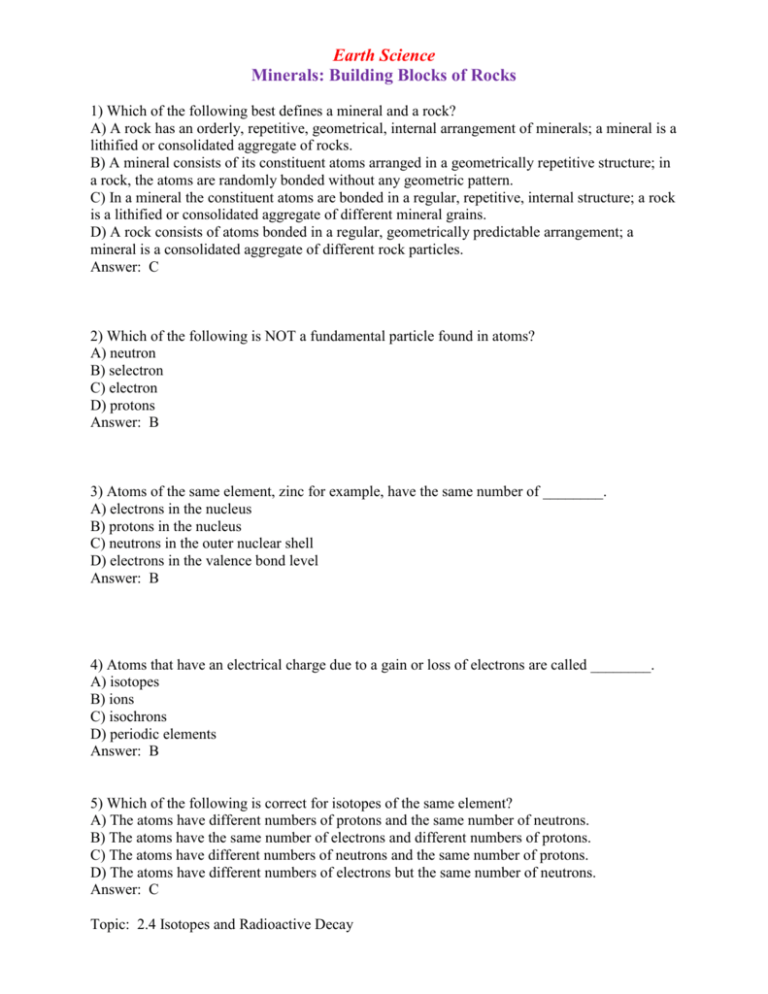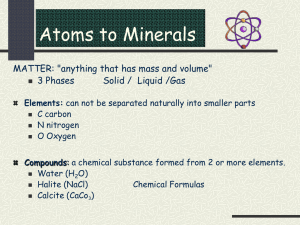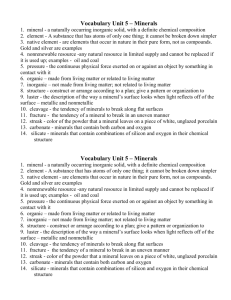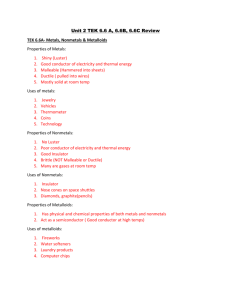Earth Science Minerals: Building Blocks of Rocks
advertisement

Earth Science Minerals: Building Blocks of Rocks 1) Which of the following best defines a mineral and a rock? A) A rock has an orderly, repetitive, geometrical, internal arrangement of minerals; a mineral is a lithified or consolidated aggregate of rocks. B) A mineral consists of its constituent atoms arranged in a geometrically repetitive structure; in a rock, the atoms are randomly bonded without any geometric pattern. C) In a mineral the constituent atoms are bonded in a regular, repetitive, internal structure; a rock is a lithified or consolidated aggregate of different mineral grains. D) A rock consists of atoms bonded in a regular, geometrically predictable arrangement; a mineral is a consolidated aggregate of different rock particles. Answer: C 2) Which of the following is NOT a fundamental particle found in atoms? A) neutron B) selectron C) electron D) protons Answer: B 3) Atoms of the same element, zinc for example, have the same number of ________. A) electrons in the nucleus B) protons in the nucleus C) neutrons in the outer nuclear shell D) electrons in the valence bond level Answer: B 4) Atoms that have an electrical charge due to a gain or loss of electrons are called ________. A) isotopes B) ions C) isochrons D) periodic elements Answer: B 5) Which of the following is correct for isotopes of the same element? A) The atoms have different numbers of protons and the same number of neutrons. B) The atoms have the same number of electrons and different numbers of protons. C) The atoms have different numbers of neutrons and the same number of protons. D) The atoms have different numbers of electrons but the same number of neutrons. Answer: C Topic: 2.4 Isotopes and Radioactive Decay 6) What mineral is the hardest known substance in nature? A) silicate B) native gold C) diamond D) muscovite Answer: C 7) Which mineral reacts readily with cool, dilute hydrochloric acid to produce visible bubbles of carbon dioxide gas? A) calcite B) quartz C) gypsum D) plagioclase Answer: A 8) Which common mineral is composed entirely of silicon and oxygen? A) calcite B) diamond C) olivine D) quartz Answer: D 9) Which of the following minerals is a silicate? A) hematite B) feldspar C) calcite D) halite Answer: B 10) A cubic centimeter of quartz, olivine, and gold weighs 2.5, 3.0, and 19.8 grams respectively. This indicates that ________. A) gold has a higher density and specific gravity than quartz and olivine B) gold is 6 to 7 times harder than olivine and quartz C) gold and olivine are silicates, whereas quartz is elemental silicon D) olivine and quartz powders are harder than metallic gold Answer: A 11) Which one of the following mineral groups exhibits a sheet-like silicate structure? A) carbonates B) pyroxenes C) micas D) feldspars Answer: C 12) The ion at the center of a silicon-oxygen tetrahedron is surrounded by ________. A) four oxygen ions B) six oxygen ions C) four sodium ions D) six sodium ions Answer: A 13) The resistance of a mineral to abrasion is known as ________. A) luster B) cleavage C) streak D) hardness Answer: D 14) All silicate minerals contain which two elements? A) iron, silicon B) silicon, sodium C) oxygen, carbon D) silicon, oxygen Answer: D 15) Which mineral has water bound into its structure? A) diamond B) talc C) gypsum D) olivine Answer: C 16) What element is the most abundant in the Earth's crust by weight? A) carbon B) chlorine C) oxygen D) sodium Answer: C 17) The strong tendency of certain minerals to break along smooth, parallel planes is known as ________. A) streak B) cleavage C) cracking luster D) habit Answer: B 18) An atom's mass number is 13 and its atomic number is 6. How many neutrons are in its nucleus? A) 19 B) 7 C) 13 D) 6 Answer: B 19) Which one of the following is NOT true for minerals? A) They have a specific, internal, crystalline structure. B) They can be a liquid, solid, or glass. C) Many have a specific, predictable chemical composition. D) They can be identified by characteristic physical properties. Answer: B 20) Which group of minerals are the most abundant in the Earth's crust? A) sulfides B) carbonates C) silicates D) halides Answer: C 21) Which the following denotes the positively charged particles in an atom's nucleus? A) protons B) electrons C) isotrons D) neutrons Answer: A 22) Which of the following has the highest specific gravity? A) wood B) water C) gold D) quartz Answer: C 23) Which of the following describes the light reflecting and transmission characteristics of a mineral? A) luster B) color streak C) virtual absorption D) fluorescence Answer: A 24) The most unreliable (variable) diagnostic property of minerals such as quartz is ________. A) hardness B) habit C) specific gravity D) color Answer: D 25) Which of the following is NOT one of the eight most common elements in the Earth's crust? A) carbon B) potassium C) aluminum D) calcium Answer: A 26) A naturally occurring concentration of one or more metallic minerals that can be extracted economically is a(n) ________. A) reserve B) ore C) resource D) tailing Answer: B Topic: 2.7 Natural Resources Word Analysis. Examine the words and/or phrases for each question below and determine the relationship among the majority of words/phrases. Choose the option which does not fit the pattern. 27) electron Answer: atom atom proton neutron 28) hardness Answer: luster fracture luster cleavage 29) quartz Answer: calcite olivine feldspar calcite 30) oxygen Answer: sulfur sulfur aluminum iron 31) All minerals exhibit cleavage. Answer: FALSE 32) Rocks are aggregates of minerals. Answer: TRUE 33) Mineral luster is broadly classified as either being metallic or opaque. Answer: FALSE 34) Electrically neutral atoms have equal numbers of electrons and protons. Answer: TRUE 35) Most minerals have a higher specific gravity than water. Answer: TRUE 36) In the silicon-oxygen tetrahedron, there are more silicon atoms than oxygen atoms. Answer: FALSE 37) More than 100 elements are currently known. Answer: TRUE 38) All atoms of the same element have the same atomic number. Answer: TRUE 39) A mineral can be composed entirely of one element. Answer: TRUE 40) Diamond and quartz are both minerals composed of a single element. Answer: FALSE 41) The micas, biotite and muscovite, both exhibit one direction of cleavage. Answer: TRUE 42) Nonmetallic minerals like halite and gypsum have no industrial uses. Answer: FALSE 43) Nearly 4000 minerals have been named. Answer: TRUE 44) Isotopes of the same element have the same mass number. Answer: FALSE Topic: 2.4 Isotopes and Radioactive Decay 45) Moh's hardness scale is a relative measure of which physical property of minerals? Answer: hardness 46) What physical property denotes the color of a powdered mineral? Answer: streak 47) The physical property denoting a mineral's tendency to crack along parallel, planar surfaces is known as ________. Answer: cleavage 48) What is the hardest mineral known? Answer: diamond 49) A compound is a stable chemical substance composed of two or more ________. Answer: elements 50) Most glasses and some minerals exhibit a type of fracture characterized by nested and curved crack surfaces. What term describes this property? Answer: conchoidal 51) What is the smallest particle of matter that exhibits and defines the distinctive chemical characteristics of the individual elements? Answer: atom 52) An aggregate minerals is called a(n) ________. Answer: rock 53) The central region of an atom is called the ________. Answer: nucleus 54) The two most abundant elements found in Earth's crust are ________ and ________. Answer: oxygen, silicon Critical Thinking and Discussion. Use complete sentences, correct spelling, and the information presented in Chapter 2 to answer the questions below. 55) Overall, the physical properties of minerals provide a reliable means to identify common minerals. However, certain properties can exhibit a range of characteristics or values making them less useful for identification purposes. Choose three physical properties that might vary considerably between samples of the same mineral and explain why such variability might exist. 56) Using the information from Table 2.1 in the text, identify five different materials that you encounter or use on a daily basis and give a possible mineral that could be mined to supply those materials. Can you think of any other considerations other than economic that might prohibit or limit the mining of certain minerals? 57) Why are most rock-forming minerals silicates? Also, considering the composition of Earth's crust, do all of the nonsilicate mineral groups make sense chemically? Why or why not? and Remembering 58) Label the various parts of an atom in the diagram below. Answer: See Figure 2.4 A in Chapter 2 of Earth Science, 13e.








